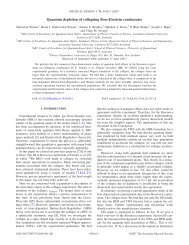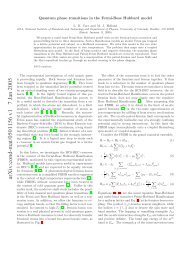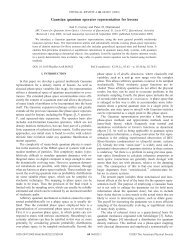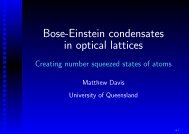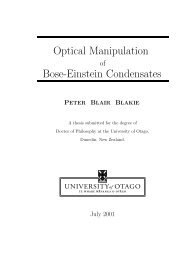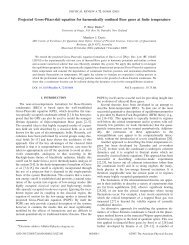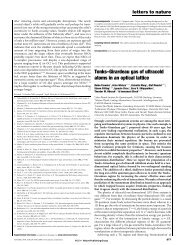- Page 1 and 2:
Open Quantum Dynamics of Mesoscopic
- Page 3 and 4:
AcknowledgementsMy thanks must firs
- Page 5 and 6:
AbstractThe properties of an atomic
- Page 7 and 8:
CONTENTS4 Continuously monitored Bo
- Page 9 and 10:
List of Figures2.1 Two-mode approxi
- Page 11 and 12:
LIST OF FIGURES7.5 Angular momentum
- Page 14 and 15:
LIST OF ABBREVIATIONS AND SYMBOLSI{
- Page 17 and 18:
1. Condensation ‘without forces
- Page 19 and 20:
1. Condensation ‘without forces
- Page 21 and 22:
Chapter 2Properties of an atomic Bo
- Page 23 and 24:
2. Properties of an atomic Bose con
- Page 25 and 26:
2. Properties of an atomic Bose con
- Page 27 and 28:
2. Properties of an atomic Bose con
- Page 29 and 30:
2. Properties of an atomic Bose con
- Page 31 and 32:
2. Properties of an atomic Bose con
- Page 33 and 34:
2. Properties of an atomic Bose con
- Page 35 and 36:
2. Properties of an atomic Bose con
- Page 37 and 38:
2. Properties of an atomic Bose con
- Page 39 and 40:
2. Properties of an atomic Bose con
- Page 41 and 42:
2. Properties of an atomic Bose con
- Page 43 and 44:
2. Properties of an atomic Bose con
- Page 45 and 46:
2. Properties of an atomic Bose con
- Page 47 and 48:
2. Properties of an atomic Bose con
- Page 49 and 50:
2. Properties of an atomic Bose con
- Page 51 and 52:
2. Properties of an atomic Bose con
- Page 53 and 54:
2. Properties of an atomic Bose con
- Page 55 and 56:
2. Properties of an atomic Bose con
- Page 57 and 58:
2. Properties of an atomic Bose con
- Page 59 and 60:
2. Properties of an atomic Bose con
- Page 62 and 63:
3. Homodyne measurements on a Bose-
- Page 64 and 65:
3. Homodyne measurements on a Bose-
- Page 66 and 67:
3. Homodyne measurements on a Bose-
- Page 68 and 69:
3. Homodyne measurements on a Bose-
- Page 70:
3. Homodyne measurements on a Bose-
- Page 75 and 76:
3. Homodyne measurements on a Bose-
- Page 77 and 78:
3. Homodyne measurements on a Bose-
- Page 79 and 80:
Chapter 4Continuously monitored con
- Page 81 and 82:
4. Continuously monitored Bose cond
- Page 83 and 84: 4. Continuously monitored Bose cond
- Page 85 and 86: 4. Continuously monitored Bose cond
- Page 87 and 88: 4. Continuously monitored Bose cond
- Page 89 and 90: 4. Continuously monitored Bose cond
- Page 91 and 92: 4. Continuously monitored Bose cond
- Page 93 and 94: 4. Continuously monitored Bose cond
- Page 95 and 96: 4. Continuously monitored Bose cond
- Page 97 and 98: 4. Continuously monitored Bose cond
- Page 99 and 100: 4. Continuously monitored Bose cond
- Page 101 and 102: 4. Continuously monitored Bose cond
- Page 103 and 104: 4. Continuously monitored Bose cond
- Page 105 and 106: 4. Continuously monitored Bose cond
- Page 107 and 108: Chapter 5Weak force detection using
- Page 109 and 110: 5. Weak force detection using a dou
- Page 111 and 112: 5. Weak force detection using a dou
- Page 113 and 114: 5. Weak force detection using a dou
- Page 115 and 116: 5. Weak force detection using a dou
- Page 117 and 118: 5. Weak force detection using a dou
- Page 119 and 120: 5. Weak force detection using a dou
- Page 121 and 122: 5. Weak force detection using a dou
- Page 123 and 124: Part IIQuantum evolution of a Bose
- Page 125 and 126: 6. Quantum effects in optical fibre
- Page 127 and 128: 6. Quantum effects in optical fibre
- Page 129 and 130: 6. Quantum effects in optical fibre
- Page 131 and 132: 6. Quantum effects in optical fibre
- Page 133: 6. Quantum effects in optical fibre
- Page 137 and 138: 6. Quantum effects in optical fibre
- Page 139 and 140: 6. Quantum effects in optical fibre
- Page 141 and 142: Chapter 7Quantum simulations of eva
- Page 143 and 144: 7. Quantum simulations of evaporati
- Page 145 and 146: 7. Quantum simulations of evaporati
- Page 147 and 148: 7. Quantum simulations of evaporati
- Page 149 and 150: 7. Quantum simulations of evaporati
- Page 151 and 152: 7. Quantum simulations of evaporati
- Page 153 and 154: 7. Quantum simulations of evaporati
- Page 155 and 156: 7. Quantum simulations of evaporati
- Page 157 and 158: 7. Quantum simulations of evaporati
- Page 159 and 160: 7. Quantum simulations of evaporati
- Page 161 and 162: 7. Quantum simulations of evaporati
- Page 163 and 164: 7. Quantum simulations of evaporati
- Page 165 and 166: 7. Quantum simulations of evaporati
- Page 167 and 168: 7. Quantum simulations of evaporati
- Page 169 and 170: 7. Quantum simulations of evaporati
- Page 171 and 172: A. Stochastic calculus in outlineco
- Page 173 and 174: Appendix BQuasiprobability distribu
- Page 175 and 176: B. Quasiprobability distributions u
- Page 177 and 178: Bibliography[1] Agrawal, G. P. Nonl
- Page 179 and 180: BIBLIOGRAPHY[22] Carter,S.J.Quantum
- Page 181 and 182: BIBLIOGRAPHY[45] Drummond, P. D., C
- Page 183 and 184: BIBLIOGRAPHY[68] Gordon,D.,andSavag
- Page 185 and 186:
BIBLIOGRAPHY[92] Jaksch,D.,Gardiner
- Page 187 and 188:
BIBLIOGRAPHY[114] Marshall, R. J.,
- Page 189 and 190:
BIBLIOGRAPHY[135] Naraschewski, M.,
- Page 191 and 192:
BIBLIOGRAPHY[158] Shelby, R. M., Le
- Page 193 and 194:
BIBLIOGRAPHY[179] Wiseman, H. M. Qu
- Page 195:
. . . but this book is already too



